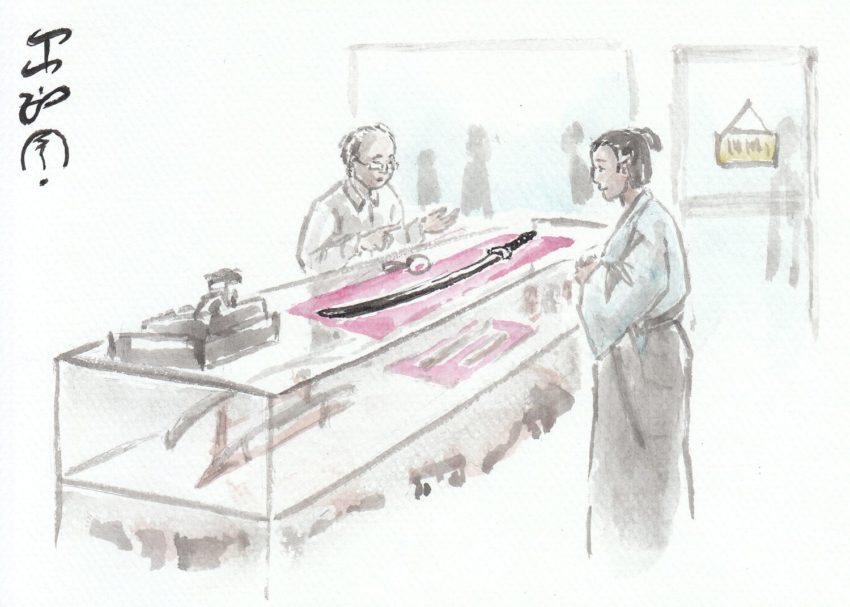Many factors must be considered during a proper Japanese sword appraisal. An educated appraiser should look at a multiplicity of important features on a sword to determine its worth. By nature of their age, swords made using the traditional methods prior to World War II will mostly likely be worth more. But that is not to say that blades created during and after World War II do not carry value for Japanese sword collectors.
The best way for you to determine the value of your sword is through a proper appraisal. You could have a great treasure on your hands! Or you might have been taken advantage of by a dishonest salesman.
Two Systems of Japanese Sword Appraisal
The main purpose of an appraisal is to receive certification after an evaluation, or kantei, of your Japanese sword. Two systems developed in Japan and the rest of the world to appraise swords.
The old system involves a simple appraisal by an authorized appraiser. This way relies more on the use of intuition than anything else, with ideas being passed down within the same family.
The more modern system of Japanese sword appraisal involves a committee of individuals recognized as experts due to their accumulated knowledge and past performance.
Where Can You Get A Good Appraisal Done?
If you have already acquired what you believe is a valuable Japanese sword, you need to verify its worth with a professional. In general, you will need to have someone extremely knowledgeable about Japanese swords carefully look over your blade. With little information, it can be virtually impossible to make an accurate appraisal.
When you first get a new sword or start to shop around, you might begin by browsing online message boards for amateur advice. This should only be your first stage of inquiries. After sharing pictures and information with other amateur collectors, you might be ready to bring your sword to a more organized, professional body. Try looking for the nearest local Japanese sword club or consider traveling to a nearby sword show when one comes reasonably close to your area.
It is important to note that a truly official appraisal and certification is issued by the association based in Japan. While American clubs and organizations can offer their professional, educated opinion about your sword’s worth, an official certificate can technically only be obtained by traveling to Japan. The two official organizations, The Society for the Preservation of Japanese Art Swords (NBTHK) and The Society for the Preservation of the Japanese Sword (NTHK), judge Japanese swords and provide documentation of valuable blades.
Main Factors When Determining Value
Appraising a Japanese sword will generally focus on certain areas of the piece. It is these that will ultimately tell you the true value of a sword.
Handmade vs. Manufactured
Handmade swords always show a visible grain, or hada, in the steel of the blade. This feature comes from the method of folding used to forge authentic Japanese swords. Swords manufactured by machines will not show the same details, especially when looked at with different lenses.
Old vs. New
One of the main distinctions used to determine a very valuable sword from a lesser blade is whether the sword is old or new. New, by the definition of Japanese swords, refers to swords from the World War II period or after.
Old Swords
- All older blades are made of steel. You can take a magnet to see for yourself.
- Old blades will also have a true temper line (hamonHAMON 刃文 "blade pattern" learn more...). This can easily be seen under a microscope.
New Swords
- A serial number found on a blade is a sure indication that the blade was manufactured by machines.
- One of the primary indicators of a new sword is if it is not sharpened all the way down to base.
- Arsenal stamps found near collar of blade are a sure sign of a World War II-period blade.
Examples of High-Value and Low-Value Swords
A set of swords in the possession of an American family since 1898 were preliminarily valued between $12,000 and $18,000. These swords, when appraised, were found to be from the 1600s. The blades, however, could not be properly evaluated due to time constraints. The final appraisal value would most likely be much higher after the blades were evaluated.
The opposite end of the spectrum would be a complete fake. You can spend hundreds of dollars in an online auction to only receive a worthless blade without the true features of a real Japanese sword. Watch buyer feedback ratings and be careful. Most sellers are on the up and up; some are not, or are mistaken themselves about an item’s value.
Blades made in Japan today using all or some of the traditional methods and techniques may also cost you a pretty penny. While not the product of a long line of Japanese history, these blades represent a better option than a poorly-made Chinese fake.
Steps in Japanese Sword Appraisal
Measure the Blade
Measuring the blade helps an evaluator determine the type of blade they are evaluating. A katana will be between 23.8 and 35.7 inches long. This is referred to as two to three shaku, which is part of a Japanese measurement system.
Evaluate the Shape
Over time, the shape of Japanese swords has changed. The length of blades, the depth of curvature, and even placement of the curve along the blade indicate different periods of Japanese sword creation. A good evaluator will be able to show you where your sword falls in time periods by evaluating the overall shape of the blade.
Evaluate the Pattern
True, handmade Japanese swords will show a distinct grain pattern on the surface of the blade from repeated folding of the steel. An evaluation can discern which grain pattern appears on a sword, which might then point towards the maker, school, or location of the manufacture.
Examine the Edge
An important part of Japanese sword appraisal is for an evaluator to examine the hamon, or the pattern shown on the temper line of a blade. Hamon patterns come in hundreds of varieties and can indicate different schools of smithing and sometimes a particular famous swordmaker.
Examine the Tang
This part of the blade is extremely important for purposes of evaluation and appraisal. The tang is never polished, which means that old blades will show dark oxidation. The shape of the tang can indicate when the blade was made and by which school.
The most important aspect of the tang, however, is that any signature will always appear on the tang. If you find a signature elsewhere, you most likely have a fake or a poor reproduction. A signature will include the name of the smith, the date it was made, and occasionally more information as to where and for who it was made.
Flaws That Lessen the Value of a Blade
Kizu are flaws that when present on a Japanese sword will lessen or completely negate its value. There are a number of documented flaws that people who conduct a proper Japanese sword appraisal will know and be able to identify.
Fakes to Avoid
A collector new to the world of Japanese swords should be careful of unsavory sellers attempting to sell poorly made and artificially aged reproductions or fakes for obscene amounts of money. Below you can find a list of several types of known fakes.
Ninja Swords: False Legends
Despite the many uncertainties involved in determining the value of Japanese swords, there is one ultimate truth: ninjaNINJA 忍者 "stalking/hiding person" learn more... swords do not technically exist! Any person attempting to sell you a special ninja sword is making up lies to make a quick buck. Ninjas did not make or use any special type of sword. (Ninajs did, however, favor certain types of blades, especially specialty items like the Japanese sword cane.)
Chinese Military Swords: Not Fake, But Not Japanese
While a lot of Chinese-manufactured blades are circulated on the market as Japanese, there are examples of legitimate Chinese military blades. It is important, however, that you can distinguish a true Japanese sword from a true Chinese sword, especially if you are explicitly looking to buy a Japanese blade. The grip of Chinese swords use checkered plastic patterns and olive drab-colored mounts. These pieces may be beautiful and collectible, but it’s always good to know exactly what you’re buying.
Know Before You Buy
Anyone looking to begin collecting Japanese swords should have a firm understanding of the complexity of Japanese sword appraisal. There are a multitude of factors that can either increase or decrease the value of any given blade. Most novice collectors will not be able to pick out those features for themselves, which is why many recommend beginning your collection with only swords that are officially certified or well-made reproductions.

